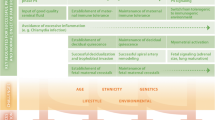Abstract
The objective of this study is to test whether the activation of toll-like receptors (TLRs) 2 and 3 (innate immune receptors for gram-positive and viral pathogens, respectively) can induce preterm delivery. One uterine horn of preterm pregnant CD-1 mice at approximately 75% of gestation was injected with TLR-2 ligands (lipoteichoic acid [LTA] or peptidoglycan [PGN]) or the TLR-3 ligand polyinosinic:cytidylic acid (poly[I:C]). Preterm delivery was recorded. In a separate group of mice, tissue mRNAs were quantified by reverse transcriptase polymerase chain reaction 5 hours after treatment with PGN or poly(I:C). Intrauterine PGN and LTA induced preterm delivery, reaching 100% at maximal doses. Intraperitoneal PGN also induced preterm delivery but at lower rates (maximum = 55%). Intrauterine poly(I:C) induced preterm birth in up to 31% of mice. Poly(I:C) induced uterine interferon β and chemokine (C-C motif) ligand 5 (CCL5, also known as RANTES) but not interleukin 1 β, tumor necrosis factor, or lipopolysaccharide-induced CXC chemokine. PGN did not alter these mRNAs when compared with saline. Neither treatment induced gene expression in fetal membranes. Activation of either TLR-2 or -3 can induce preterm delivery in the mouse. Activation of TLR-3 with poly(I:C) induces interferon β and the chemokine CCL5 in uterine tissues but not in fetal membranes.
Similar content being viewed by others
References
Klein LL, Gibbs RS. Use of microbial cultures and antibiotics in the prevention of infection-associated preterm birth. Am J Obstet Gynecol. 2004;190:1493–1502.
Elovitz MA, Wang Z, Chien EK, Rychlik DF, Phillippe M. A new model for inflammation-induced preterm birth: the role of platelet-activating factor and toll-like receptor-4. Am J Pathol. 2003;163:2103–2111.
Kajikawa S, Kaga N, Futamura Y, Kakinuma C, Shibutani Y. Lipoteichoic acid induces preterm delivery in mice. J Pharmacol Toxicol Methods. 1998;39:147–154.
Wang H, Hirsch E. Bacterially-induced preterm labor and regulation of prostaglandin metabolizing enzyme expression in mice: the role of toll-like receptor 4. Biol Reprod. 2003;69:1957–1963.
Takeuchi O, Hoshino K, Kawai T, et al. Differential roles of TLR2 and TLR4 in recognition of gram-negative and gram-positive bacterial cell wall components. Immunity. 1999;11:443–451.
Alexopoulou L, Holt AC, Medzhitov R, Flavell RA. Recognition of double-stranded RNA and activation of NF-kappaB by toll-like receptor 3. Nature. 2001;413:732–738.
Poltorak A, He X, Smirnova I, et al. Defective LPS signaling in C3H/HeJ and C57BL/10ScCr mice: mutations in Tlr4 gene. Science. 1998;282:2085–2088.
Qureshi ST, Lariviere L, Leveque G, et al. Endotoxin-tolerant mice have mutations in toll-like receptor 4 (Tlr4). J Exp Med. 1999;189:615–625.
Mazzoni A, Segal DM. Controlling the toll road to dendritic cell polarization. J Leukoc Biol. 2004;75:721–730.
Molloy EJ, O’Neill AJ, Grantham JJ, et al. Labor induces a maternal inflammatory response syndrome. Am J Obstet Gynecol. 2004;190:448–455.
Zarember KA, Godowski PJ. Tissue expression of human toll-like receptors and differential regulation of toll-like receptor mRNAs in leukocytes in response to microbes, their products, and cytokines. J Immunol. 2002;168:554–561.
Holmlund U, Cebers G, Dahlfors AR, et al. Expression and regulation of the pattern recognition receptors toll-like receptor-2 and toll-like receptor-4 in the human placenta. Immunology. 2002;107:145–151.
Kumazaki K, Nakayama M, Yanagihara I, Suehara N, Wada Y. Immunohistochemical distribution of toll-like receptor 4 in term and preterm human placentas from normal and complicated pregnancy including chorioamnionitis. Hum Pathol. 2004;35:47–54.
Harju K, Glumoff V, Hallman M. Ontogeny of toll-like receptors Tlr2 and Tlr4 in mice. Pediatr Res. 2001;49:81–83.
Takeda K, Kaisho T, Akira S. Toll-like receptors. Annu Rev Immunol. 2003;21:335–376.
Hirsch E, Wang H. The molecular pathophysiology of bacterially induced preterm labor: insights from the murine model. J Soc Gynecol Investig. 2005;12:145–155.
Mussalli GM, Blanchard R, Brunnert SR, Hirsch E. Inflammatory cytokines in a murine model of infection-induced preterm labor: cause or effect? J Soc Gynecol Invest. 1999;6:188–195.
Schaefer TM, Fahey JV, Wright JA, Wira CR. Innate immunity in the human female reproductive tract: antiviral response of uterine epithelial cells to the TLR3 agonist poly(I:C). J Immunol. 2005;174:992–1002.
Jeyaseelan S, Young SK, Yamamoto M, et al.Toll/IL-1R domain-containing adaptor protein (TIRAP) is a critical mediator of antibacterial defense in the lung against Klebsiella pneumoniae but not Pseudomonas aeruginosa. J Immunol. 2006; 177:538–547.
Akira S, Uematsu S, Takeuchi O. Pathogen recognition and innate immunity. Cell. 2006;124:783–801.
Lin R, Heylbroeck C, Genin P, Pitha PM, Hiscott J. Essential role of interferon regulatory factor 3 in direct activation of RANTES chemokine transcription. Mol Cell Biol. 1999;19: 959–966.
Author information
Authors and Affiliations
Corresponding author
Additional information
This work was funded in part by 1RO1HD41689. We thank Lennard Wahlberg for technical assistance.
Rights and permissions
About this article
Cite this article
Ilievski, V., Lu, SJ. & Hirsch, E. Activation of Toll-like Receptors 2 or 3 and Preterm Delivery in the Mouse. Reprod. Sci. 14, 315–320 (2007). https://doi.org/10.1177/1933719107302959
Published:
Issue Date:
DOI: https://doi.org/10.1177/1933719107302959




